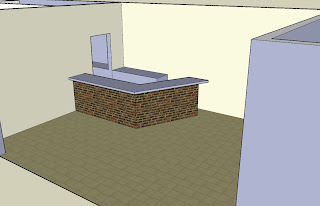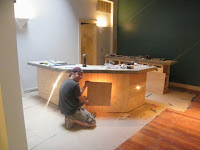Step 1. Drawing and Layout
We knew what we wanted, but had no idea of the size relative to the room. We started by outlining the work area in painter's tape on the newly installed hardwood floor (see earlier posts). After seeing how the space worked, I attacked Google SketchUp and came up with a concept for it.

Step 2. Build Basic Structure of Counters
OK, my amateur rendering looked great! Or so we thought...Turns out, the scale was way off. Anyhow, I figured I'd just start building it because I can visualise things much better when I'm making them (duh!). Head to Lowes and picked up our basic materials:
- 2 sheets OSB for the top and bottom frames
- Around twenty or so 8' 2"x3" boards
- 4 sheets nicer Ply Sheathing, for the face of the cabinets where they'll get abused
- Misc. multi-purpose drywall screws
- around 15 8' 1"x4" (Why you ask? Concrete tray...You'll see)






One thing that turned out to be a challenge was building the concrete tray/lip for around the edges (with the 1"x4"!). I wanted the concrete to completely wrap around the top OSB board, and hand around the lip so that it looked like a floating slab. With around 3" on the edges, the concrete would be just over 2" everywhere else. Notice the cool recessed area for where we plan to put a cash register? This way we can bolt it down and it will be accessible yet hidden. Also, we had to caulk all of the inside of the concrete tray to account for any wet concrete slurry that might come through.
Step 3. Pouring the Concrete Tops
Now we have our forms in place. If you're going to do something like this I would suggest making them where they will stay permanently. After we add the concrete to the tops, they get extremely heavy and you'll need a team to move one. We went back to Lowes and got:
- Chicken wire (small scale mesh rebar)
- 2' Rebar sections to place in high-stress sections (corners and overhangs)
- A few bags of Fiber-reinforced concrete mix.
- A few bags of finer-finish concrete






You'll want to screed the excess concrete with a straight piece of wood. Then, Because I wanted a smooth surface along the face of the concrete, I used a vibrator to push out the air bubbles. I didn't have a professional concrete vibrator, but being resourceful, a blade-less sawzall will do the trick.
Let this sit for around 2 or 3 hours, then finish with a steel float. Cover, and let cure for 36-48 hours. Once the concrete has cured, you can CAREFULLY remove the forms around the lip, and voila!






Step 4. Wet Grinding Our Way To A Beautiful Finish
The counters are not done, oh not by a long shot. They currently feel like a sidewalk or other finished concrete surface. But what we're going for here is a countertop (a safe and sanitary one at that and it needs to be able to be cleaned). So, this is where the craziest step in the whole process lies: the wet grinder. What is a wet grinder? It's a grinder like you're used to, but with a hose that allows water to flow through the middle of the wheel for cooling of the diamond pads that we're using. If you go to do this, know that it will be VERY wet. We covered the floors and walls with tarps to protect them, but we had no idea how long this would take or how much water would be used. Let's just say, over the course of 4 hours, using varying degrees of wet grinder pads, we dumped the equivalent of a 55-gallon drum of water on the project. That's a lot of cleanup! Unfortunately, this was so messy I didn't get the camera out much. Here's the photos, notice the glassy reflective surface:



Step 5. Not Done Yet! Seal and Wax
Sadly, this is the one area that I wish I could do again. As the counters dried after the wet grinding, we realized they returned to their light gray color. There are mulitple ways recommended on how to seal the concrete counters for use. The options are usually between using an epoxy clear-coat sealer or a water-based sealer. We chose the water-based sealer because it was (a) cheaper, and (b) less-toxic and would dry much quicker. After application however, it never gave us that wet glassy look like above. It was more of a damp, semi-reflective look. Oh well.
Once that dried over a few days, we then applied the last step: Wax Polish. We ordered CHENG Concrete Wax and applied as directed with a buffer. This was a bit tricky, but once it was buffed out, we got more of that reflective, glassy-smooth result we were looking for.
Step 5. Now Finish The Rest Of The Counter
Now that our concrete counter top is complete, I built the rest of the units. One unique thing we added was custom lighting to the front of the counters to mimic the lighting already in the cafe. A bit of paint, trim around the edges, and we can call this a finished project!

If you have any questions or comments, I'd love the hear them! This was a fun project and I hope this will help you if you ever want to build you own cheap and durable concrete counters.